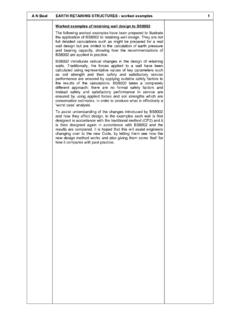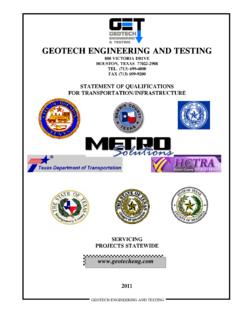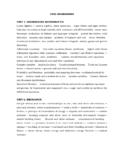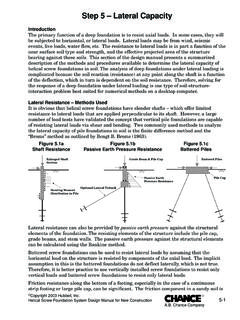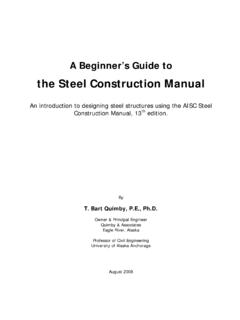Transcription of CIVIL ENGINEERING CODE OF PRACTICE No. 4 …
1 SECTION bearing capacity OF Determination of ultimate bearing capacityThe ultimate bearing capacity of timber, precastconcrete or steel piles is most accurately determinedfrom test loading, vide Item In non-cohesive soilsthe probable bearing capacity may be deduced from oneof the dynamic pile formulae. However, many of theseare very unreliable and it is recommended that anapproximate value may be obtained from the Hileyformula in accordance with Item In cohesive soilsan approximate value of the probable bearing capacitymay be obtained by tests on soil samples in accordancewith Item Alternatively the bearing capacity ofpiles depending mainly on end- bearing resistance maybe extrapolated from the results obtained from deeppenetration tests as described in Item (1).Where piles are required to be driven in groups itmay be advisable to apply test loads to groups of at leastfour piles placed at the intended spacing rather than tosingle piles.
2 This procedure is recommended wherepiles are predominantly friction piles driven intocohesive soils (see Item ). These tests should becarried out as described in Item The remainingpiles should be driven to the set or the depth indicatedby the results of these fundamental assumption made in all dynamicformulae is that the resistance of piles to furtherpenetration under the permanent load has a directrelationship to their resistance to the impact of thehammer at the time of driving. Dynamic formulae maygive reasonably accurate results in gravels, coarsesands, and similar deposits, which on account of theirhigh permeability permit the free movement of theirmoisture content and therefore do not present asubstantially different resistance to the impact forces ofdriving than to the subsequent permanent formulae are not applicable to deposits suchas saturated silts, muds, and clays. In these soils theresistance to impact of the toe of the pile is exaggeratedby their low permeability, while the frictional resistanceon its sides during driving is reduced by tendency of the ground to alter its resistanceafter driving, which is usual with the fine-grained soils,should be ascertained by re-driving the test piles and anoccasional working pile after a period of rest.
3 Loadingtests on such piles immediately after driving thereforemay tend to be misleading, and it is preferable to deferthem for as long as of the ground or the lifting of adjacent pilesalready driven as the result of driving operations is aneffect of low permeability in saturated bearing capacity of friction piles embedded fortheir whole length in a uniform cohesive soil may bededuced approximately from laboratory tests of the soilas described in Item That of driven cast-in-placepiles may be determined as recommended above forother types of driven piles. When obtained from a pileformula, an increase in bearing capacity may be allowedwhere additional resistance can be developed by thefriction of the finished pile against the surrounding soilafter the casing has been withdrawn. However, formulaeare not applicable to systems which provide an enlargedbase to the foot of the bearing capacity of bored cast-in-place pilesshould be obtained from test loadings or in accordancewith Item Alternatively, the safe load may beestimated from the known bearing capacity of otherpiles of similar dimensions and deriving their resistancefrom the same PRACTICE , piles are often driven into a succession ofdifferent strata.
4 In such cases the nature and thickness ofthe stratum in which the point of the pile rests willlargely influence the carrying capacity . Thecharacteristics, thickness and inclination of the strataunderlying the pile points have a preponderatinginfluence on the settlement of the structure as a should not, therefore, be placed only on piletests in such soils in estimating overall settlement. Thepossibility of settlement due to the consolidation of thesoil below the pile points should be investigated andtaken into account (see Items and )In other cases the characteristics of the soil will beintermediate between those of non-cohesive andcohesive soils. In such cases considerable judgement isnecessary in deciding on the means to be adopted inassessing the bearing capacity : test loadings should becarried out wherever is necessary to give an important warning withregard to piles driven through soft, sensitive clay.
5 Thedriving of piles through such clay causes a remouldingof the material and renders it subject to settlement underits own weight. Due to this settlement the claysurrounding the piles will move downwards relative tothem and will thus induce a negative, or downward-acting, skin friction. The total downward force due tothis skin friction may be estimated as the cohesion ofremoulded specimens of the clay multiplied by theCIVIL ENGINEERING CODE OF PRACTICE No. 4 (1954) ENGINEERING Codes of PRACTICE Joint CommitteeTHE INSTITUTION OF CIVIL ENGINEERS - THE INSTITUTION OF WATER ENGINEERS - THEINSTITUTION OF MUNICIPAL ENGINEERS - THE INSTITUTION OF STRUCTURAL ENGINEERSI ssued on behalf of the Committee byThe Institution of CIVIL Engineers, 1 Great George Street, Westminster, SW1 Metric conversion by Alasdair Bealsurface area of the pile or the full weight of the soilbetween and around the piles, whichever is less, andshould be deducted from the bearing capacity of a singlepile as found by test or by formula in order to give thetrue bearing capacity of the pile.
6 Provided that thisprecaution is taken, little trouble is likely to beexperienced with piles driven through clay and into sandor gravel, but appreciable settlements may occur withdriven piles embedded wholly in clay; in such casesbored piles may be preferable to driven piles andremoulding of the clay and the incidence of negativeskin friction thereby deciding the safe load on piles driven through arecently-deposited fill, allowance should be made forthe additional load which will be imposed on them byits continued consolidation. This need not exceed thefull weight of the material which is likely to betransferred to a pile or pile group during theconsolidation of the fill around the Dynamic pile formulaeThese are based on the laws governing the dynamicimpact of elastic bodies; they equate the energy of thehammer blow to the work done in overcoming theresistance of the ground to the penetration of the is made for losses of energy due to theelastic contractions of the pile, cap and subsoil, as wellas the losses caused by the inertia of the pile.
7 One of themost used of these formulae is the Hiley Hiley formula is:R = Wh /(S + C/2)whereR is the ultimate driving resistance in kNW is the weight of the ram in is the height of the free fall of the ram or hammer (inmm), taken at its full value for trigger-operateddrop hammers, 80% of the fall of normally-proportioned winch-operated drop hammers and90% of stroke for single-acting hammers. Whenusing the McKiernan-Terry type of double-actinghammers, 90% of the rated energy in kNmm perblow should be substituted for the product Wh inthe formula. The hammer should be operated at itsmaximum speed whilst the set is being is the final set or penetration per blow in is the sum of the temporary elastic compressions (inmm) of the pile, dolly, packings, and ground,calculated or measured as prescribed below. is the efficiency of the blow, representing the ratio ofenergy after impact to striking energy of W is greater than Pe and the pile is driveninto penetrable ground: = (W+Pe )/(W+P)Where W is less than Pe and the pile is driven intopenetrable ground: = (W +Pe )/(W+P) - ((W-Pe)/(W+P)) Values of in relation to e and to the ratio P/W aretabulated in Appendix is the weight of the pile, anvil, helmet and follower(if any) in kN.
8 Where the pile finds refusal in rock, should be substituted for P in the aboveexpressions for .e is the coefficient of restitution of the materials under impact as tabulated in Appendix single-acting or drop hammers work ininclined leader guides, the percentages given in Table 4should be deducted from the calculated bearing 4. Reduced bearing Values for Raking PilesRake Per cent reduction1 in 12 in 10 in 8 in 6 in 5 in 4 in 3 in 2 temporary compression of the pile and groundoccurring during driving should be determined by sitemeasurements whenever possible, especially when theset is small, as described in Appendix C. Thecompression of the dolly and packing, as tabulated inthe Appendix, should be added to the measuredcompression. When measurements cannot be taken, thetemporary compressions of the pile and ground may beestimated from the values tabulated in that calculating the value of the driving resistance fromthe Hiley formula it is first necessary to assume a valuefor the cross-sectional stress and to obtain thecorresponding value of C.
9 When R has been obtained,the cross-sectional stress should be checked with thatpreviously estimated and the calculation repeated ifnecessary until agreement is obtained by trial and method of determining R directly is byexpressing the value of C in terms of R and solving bythe aid of the quadratic equation given in Appendix facilitate computations of driving resistance forvarious conditions in driving timber and reinforcedconcrete piles, tables and graphs* may be consulted forvalues based on the Hiley formula.* R. V. Allin, MICE, Resistance of Piles to Penetration(2nd Ed.), E & FN Spon, 15 Bedford St., London Driving stressesThe driving stresses in the pile are likely to begreatest at the head of the pile and can be estimatedapproximately by dividing the driving resistance by thecross-sectional area of the pile and multiplying this by(2/ ) - 1, where is the efficiency of the blow, toobtain the peak head-stress value.
10 For reinforced-concrete piles reference should be made to Paper No. 20. (See also Item )As far as possible, raking piles should be supportedduring driving right down to the level at which theyenter reasonably solid ground. Failing this, theadditional stresses due to their spanning beyond thebottom end of the leaders and the further stresses due tothe fact that the blow comes on the pile when it isdeflected, should be Factor of safetyThe factor of safety should be chosen afterconsidering (a) the reliability of the ultimate resistance,(b) the type of superstructure and loading, and (c) theallowable settlement, both differential and ultimate resistance should be obtained wheneverpracticable from test loadings, as recommended in If a sufficient proportion of the piles are tested inthis manner, the data obtained from the tests may beused for adjusting the coefficients in the pile formula,which can then control the driving of the remainingpiles.

